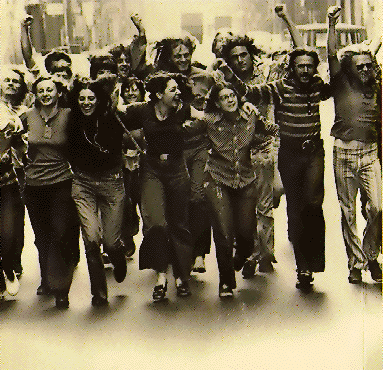A week or so ago, a group of high school sophomores asked me what the Stonewall Riots were. I could give the basic survey answer: 1969, New York, the spark for the gay liberation movement. The basics. But my young friends
 wanted to know more. What, exactly, happened, and why?
wanted to know more. What, exactly, happened, and why?We went to the internet to poke around. And there, on some basic website, we found a throwaway line that went something like: “although the Stonewall Inn was owned by the Mafia . . .”
This was certainly news to me, so I wrote to ask Jennifer Fronc, author of New York Undercover, about it. She studies moral policing in communities and law, so I figured she might know why the Mafia owned a gay bar. She did. She answered:
The Stonewall Inn, and most gay bars in NYC at the time, were, in fact, owned by the Mafia (or at least petty criminals of Italian-American descent). The reason that they owned them was purely as a business venture--not out of some sense of civil rights or justice. The New York State Liquor Authority had very strict codes about dress and conduct in public houses, and you could easily lose your liquor license if your patrons did not abide by those codes. So, in the case of gay bars, the codes that affected the patrons were no same-sex kissing, touching, or dancing, and your patrons were required to wear 5 articles of clothing that corresponded with their biological sex (this was targeting drag queens but ended up nailing dykes much harder). So, what started happening is the cops would raid gay bars and frisk/strip search the patrons to make sure they were wearing the right clothes. Bar owners couldn't afford to pay off the police or get back their licenses after raids like this, so the mafia stepped in and started running the gay bars and paying off the local cops….
The Stonewall Inn was a frequent target of those raids, and there are 2 theories as to why they rioted that night, which was like any other: 1. they were just fed up and 2. the memorial service for Judy Garland had been earlier that night, and the men were drunker than usual. Although it was allegedly a tough dyke who threw the first punch at the cops.
The Stonewall Inn was a frequent target of those raids, and there are 2 theories as to why they rioted that night, which was like any other: 1. they were just fed up and 2. the memorial service for Judy Garland had been earlier that night, and the men were drunker than usual. Although it was allegedly a tough dyke who threw the first punch at the cops.
For contemporary newspaper clippings, she sent me to an online exhibit at Columbia University:
This is, itself, one of those great connections in history (like Elvis and Nixon) that make it possible to survive January in New England. But it also raises for me two other issues.
First, it indicates the importance of a renewed historiographical interest in societal systems. In this case, the New York code dictating dress in public had huge implications for gay culture, suggesting that we must understand the legal codes in order to understand what happened at Stonewall. That code also clearly had big economic repercussions for business owners, suggesting that we cannot understand discrimination without looking closely at the economic systems with which it is intertwined.
There is a strong tendency among historians of America to see legal history, economic history, political history, and the study of similar systems as old-fashioned and reactionary, but it seems to me the very opposite is true. We can’t understand most aspects of social history completely without these systems factored in.
Second, the fact these high school students came to a neighbor who teaches history for information on Stonewall speaks to this blog’s on-going discussion of teaching. They asked me about Stonewall because they have a teacher who always has the answer to everything. They figured out in the first two days that she was often wrong, and their education has taken a fascinating turn. Rather than being turned off to history, the students have made it a game to learn everything better than she knows it. (The Stonewall question apparently came up when she tried to tell them that the “Stonewall Riots” had something to do with Stonewall Jackson.) Had she assigned them an essay on Stonewall, they likely would have grumbled and done as little as possible. But since they were doing it for themselves, they took their own time to find answers, and they didn’t stop with the job half done.
While making things up to drive students to try to embarrass us is hardly a model for how to teach, it does suggest that our job is less to have all the answers than to have enough answers just to whet curiosity, and then to make sure our students know how to keep learning. This, curiously enough, is the conclusion of a new study on learning conducted at the University of California.
[Thanks to Jennifer Fronc for her information, and for letting me post from her email.]






1 comment:
Can't help but say it's nice to see that Italians operating outside the law are occasionally a social good! Gives me hope...
But seriously, talk about unintended consequences!
Post a Comment